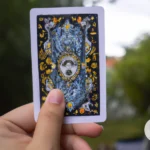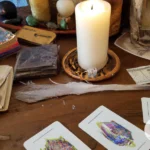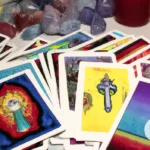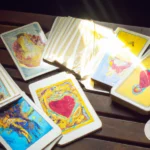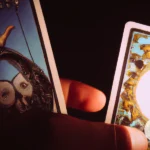The use of Tarot in modern spirituality has become increasingly prevalent in recent years. There is a certain mysterious allure to the practice that draws people in, prompting them to explore its rich history and its impact on contemporary spiritual practices. What is the story behind the Tarot cards? How have they been used throughout history as a tool of divination and connection to the spiritual realm? And what benefits and possibilities does Tarot hold for modern seekers? In this article, we will delve into the fascinating world of Tarot and its influence on spiritual quests in the present day.
The History of Tarot and its Roots in Spirituality
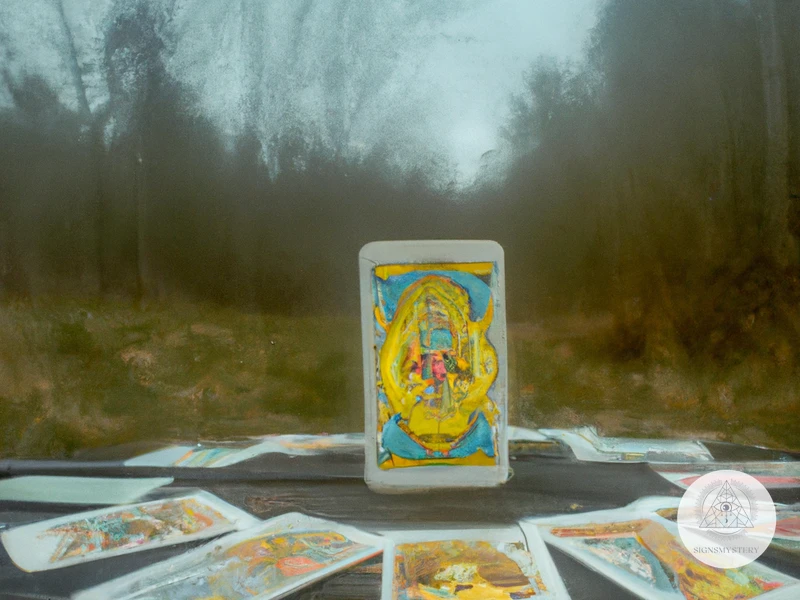
The tarot deck has been shrouded in mystery and fascination for centuries, with a rich history that traces back to different parts of the world. Tarot enthusiasts and spiritual practitioners alike view the cards as much more than a tool for divination, seeing them as a symbol of culture, ancient wisdom, and profound spiritual knowledge. In this section, we will explore the roots of tarot in spirituality, including the origins of the deck, its significance in spiritual practices, and its evolution throughout different cultures and historical moments. [You can explore the evolution of tarot with this timeline of tarot history.]
The Origins of Tarot
The origins of tarot are somewhat mysterious, with several theories about its origins. One theory suggests that tarot was created by the ancient Egyptians, as some of the cards feature Egyptian symbols and hieroglyphs. However, there is no concrete evidence to support this theory.
Another theory suggests that tarot cards were developed in Renaissance Italy as playing cards, and only later became associated with divination and spirituality. The major arcana cards in particular were thought to represent various virtues and vices.
Some experts believe that tarot’s roots are in Hermeticism, a spiritual and philosophical movement that emerged during the Italian Renaissance. Hermeticism emphasized the interconnection between the physical and spiritual worlds, and tarot was seen as a tool for exploring this connection.
Others believe that tarot has its origins in the occult, and was used as a tool for magical rituals and divination. The symbolism of tarot cards was thought to have esoteric meanings that could be used to gain insight into the spiritual realms.
Despite these various theories, the exact origins of tarot remain shrouded in mystery. What is clear, however, is that tarot has played an important role in spiritual and cultural practices throughout history, from its early use as playing cards in Renaissance Italy, to its popularity in France during the 1700s, to its journey across Europe and the world.
Tarot in Spiritual Practices
Tarot has been an essential part of spiritual practices for centuries. It has always been used as a tool to connect with the divine and gain insight into one’s life. In fact, the roots of tarot can be traced back to the ancient Egyptian civilization, where it was used as a tool for divination.
The symbolism of tarot suits has its origins in ancient traditions and has been used to represent various themes such as power, creativity, emotions, and perseverance. The Major Arcana, which consists of 22 cards, has been particularly significant in spiritual practices, representing major life events, spiritual development, and transformation.
Tarot became increasingly popular during the Renaissance period in Italy, particularly among the noble class. It was during this time that the tarot began to be seen as a tool for spiritual and personal growth. The influence of Hermeticism and the occult played an important role in the development of tarot symbolism and interpretation.
Tarot’s popularity continued to grow in France during the 18th century, where it was used as a form of divination and entertainment among aristocrats. The Tarot de Marseille, with its classic imagery and symbolism, emerged as the most widely used tarot deck during this time.
Today, tarot is used by millions of people around the world as a tool for spiritual growth and self-discovery. The tarot journey has spread from Europe to the rest of the world and has evolved to include various interpretations and practices. While some still view it as a form of divination, others use it as a tool for mindfulness, reflection, and manifestation.
Tarot has played a significant role in spiritual practices throughout history and continues to impact modern spirituality in diverse ways.
Tarot’s Cultural Significance
Tarot’s cultural significance is undeniable. The symbolism and imagery used in tarot cards have both reflected and influenced various cultures throughout history.
The tarot has its origins in various cultural and spiritual practices, from Egypt to Renaissance Italy. The Mysterious Origins of Major Arcana, for example, suggest a deep connection to ancient mythology and religion. Egyptian Tarot History notes that the tarot’s earliest roots may be found in the Book of Thoth, which was believed to be a guide to the Egyptian afterlife. This ancient connection shows the relevance of tarot even today.
During the Renaissance, tarot became popular in Italy, and it spread throughout Europe and the world. The Tarot Renaissance Italy marked a significant period where tarot decks were used not only for divination but also as educational tools. The symbolism of the Tarot Suits Origins, for example, reflects the values and beliefs of medieval European society.
Tarot has strong links to hermeticism, an ancient spiritual, and philosophical movement that emphasized the link between the microcosm and macrocosm. The influence of hermeticism is evident in many tarot decks, including the Rider-Waite deck, which features hermetic symbolism, such as the four elements and the caduceus of Hermes. More on this topic can be found in Hermeticism Tarot Influence.
In the world of the occult, tarot has been linked to mystical practices like alchemy, astrology, and Kabbalah. In Tarot Occult Connection, one can explore the idea of tarot as a tool for esoteric knowledge and spiritual transformation.
Tarot’s popularity during the eighteenth century in France marked a time when tarot was widely used for divination and fortune-telling. Tarot’s Popularity France marked its acceptance as a cultural phenomenon that continued to evolve and grow.
Today, tarot culture is global, connecting people from different backgrounds and beliefs. The Tarot Journey Europe World celebrates the diversity of tarot and its enduring legacy. The interconnectedness of the world has been instrumental in promoting tarot, and tarot has been instrumental in promoting unity and understanding.
Thus, tarot’s cultural significance is vast and profound, reflecting the human desire to understand ourselves and the world around us. Tarot continues to evolve and grow, leaving a deep and lasting impact on modern spirituality.
How Tarot Affects Modern Spirituality
As we delve deeper into the world of tarot, we begin to understand its profound impact on modern spirituality. This ancient practice has evolved over the centuries to become an instrumental tool for self-discovery and personal growth. To fully grasp the significance of tarot in modern spirituality, it is essential to explore its origins, its role in spiritual practices, and its cultural significance. By uncovering the many ways in which tarot affects modern spirituality, we can gain a better understanding of its transformative power and its potential to help us connect more deeply with ourselves and the world around us. To do so, let’s explore the following sections in detail.
Tarot as a Tool for Self-Discovery
Tarot has become a popular tool for self-discovery in modern spirituality. Many people use tarot cards to gain insight into their own personality, emotions, and life situations. It offers them a way to explore their inner selves, bringing awareness to what might be hidden or unconscious within them. The use of tarot cards as a tool for self-discovery dates back to the early history of tarot, where it was primarily used for divination purposes. Today, tarot serves as a guide for people seeking to understand themselves better.
What is Self-Discovery?
Self-discovery is a process of understanding oneself, including one’s thoughts, emotions, strengths, weaknesses, and desires. It is a journey of gaining insights into one’s personality, behavior, and motivations. Self-discovery is important for personal growth and development, as it helps individuals become more self-aware and better equipped to navigate life’s challenges.
The Role of Tarot in Self-Discovery
Tarot can be used as a tool for self-discovery by providing insights into one’s subconscious mind. It can reveal what is hidden, suppressed, or unknown, allowing individuals to gain clarity about themselves, their relationships, and their life purpose. Tarot readings can help individuals identify their strengths, weaknesses, and blind spots, leading to a deeper understanding of oneself.
The Benefits of Using Tarot for Self-Discovery
There are several benefits to using tarot cards as a tool for self-discovery. Here are some of them:
| Benefits of Using Tarot for Self-Discovery |
|---|
| • Provides deeper insights into oneself |
| • Helps to identify patterns and behaviors |
| • Offers guidance and clarity |
| • Promotes self-reflection and self-awareness |
| • Encourages personal growth and development |
How to Use Tarot for Self-Discovery
To use tarot cards for self-discovery, one should approach the practice with an open mind and a willingness to explore. Here are some steps to follow:
1. Choose a tarot deck that resonates with you.
2. Take time to meditate and set intentions. Think about what you hope to gain from the reading.
3. Shuffle the cards while focusing on your question or intention.
4. Pull a card or a spread of cards and reflect on their meanings.
5. Write down your thoughts and feelings about the reading. Pay attention to what thoughts, feelings, or insights arise.
6. Take action based on the insights gained from the reading.
Conclusion
Tarot has become a valuable tool for self-discovery in modern spirituality. It provides insight into one’s subconscious, helping to identify patterns, behaviors, and blind spots. By using tarot cards, individuals can gain a deeper understanding of themselves and their life purpose, leading to personal growth and development. If you want to learn more about the history of tarot and its role in spirituality, check out Tarot’s Journey through Europe and the World.
Tarot’s Role in Personal and Spiritual Growth
Tarot is more than just a deck of cards, it can serve as a catalyst for personal and spiritual growth. When used with intention and purpose, the cards can provide a framework for exploring our inner selves and the world around us. Tarot readings can offer insight and guidance, helping people to gain a deeper understanding of themselves and their place in the universe.
One of Tarot’s most significant roles is in facilitating personal and spiritual growth. The rich symbolism of the cards can help us to become more in touch with our inner selves and connect with the spiritual realm. As we delve deeper into the cards, we can gain insights into our own personalities, values, and motivations. This, in turn, can help us to make positive changes in our lives and to grow as individuals.
Through Tarot, we can also gain a deeper understanding of the world around us. The cards offer a language for interpreting the energies and influences that shape our lives. By learning to read the cards, we can begin to see patterns and connections between different events and experiences. This, in turn, can help us to make wiser choices and navigate the challenges of life with greater ease and clarity.
Tarot can help us tap into our own intuition and inner wisdom. By learning to trust our instincts and our own inner voice, we can become more empowered and make better decisions. Tarot can help us to see the possibilities that exist within us and around us, and to take action to realize them.
Tarot can be a powerful tool for spiritual and personal growth. Its ability to offer insight, guidance, and inspiration makes it a valuable resource for anyone seeking to deepen their understanding of themselves and the world around them. As Tarot continues to evolve and grow in popularity in the modern world, it will undoubtedly continue to play an important role in helping people to achieve greater self-awareness and spiritual fulfillment.
To learn more about the history of tarot and its roots in spirituality, read about Tarot’s Renaissance in Italy or the influence of Hermeticism on Tarot in our previous articles.
People and Tarot: Building Connections
It is remarkable how tarot cards, a centuries-old tool for divination, continue to build connections among people of all backgrounds in contemporary times. Tarot has become a common ground upon which people can share personal stories, views on spirituality, and beliefs. The shared experience of interpreting tarot cards and reflecting on their meanings creates a bond that transcends age, gender, and culture.
One reason why people find tarot so appealing is the sense of mystery and intrigue associated with it. From the intricate designs juxtaposed against a black background to the mysterious symbols that populate its cards, everything about tarot seems to invite curiosity and interpretation. Even the origins of tarot itself are shrouded in mystery, with historians still debating its true roots.
Another reason why people connect with tarot is its accessibility. Unlike other spiritual practices that require specific training or costly tools, tarot only requires a deck of cards, a quiet space, and an open mind. Nearly everyone can find a deck that resonates with them, with numerous options ranging from the traditional Rider-Waite-Smith deck to the modern and diverse myriad of tarot decks.
Tarot has the power to bring people together and facilitate meaningful conversations. Whether it’s in a tarot reading or tarot study group, people can reflect on the meanings of tarot cards and how they relate to their own lives. Sharing personal stories and experiences with others can help build empathy and understanding, which are integral parts of human connection.
Despite the criticisms tarot has faced throughout history and in contemporary times, it remains a powerful tool for building bridges among people of different backgrounds. It has become a symbol of spiritual exploration and personal growth, inviting everyone to embark on their own unique journey. As tarot continues to grow in popularity, it is worth examining how this ancient practice helps us understand ourselves and connect with others on a deeper level.
One interesting example of tarot’s widespread popularity is its historical significance in France. Despite being banned at certain times throughout its history, tarot has remained a popular pastime and spiritual practice in France. It even became a part of mainstream culture during the 18th century, with many notable French writers and poets using tarot as a tool for creative inspiration. Today, the French continue to celebrate tarot in various festivals and events, highlighting its importance as a cultural and spiritual phenomenon.
The Benefits of Tarot for Modern Spiritual Practices

Tarot has become a popular tool for modern spirituality due to its ability to aid individuals on their personal and spiritual journeys. Whether it’s through developing intuition or practicing mindfulness and reflection, tarot has a variety of benefits that can enhance one’s spiritual experiences. These benefits are rooted in the long history of tarot and its associations with spirituality and divination. From the mysterious origins of the major arcana to the symbolism of tarot suits, tarot has been an integral part of spiritual practices throughout history. The occult and mystical connections of tarot have also contributed to its popularity in modern spirituality. To fully understand the benefits of tarot in modern spiritual practices, it’s important to explore its history and cultural significance.
Developing Intuition and Spiritual Connection with Tarot
Tarot cards are a powerful tool for developing intuition and spiritual connection. The intuitive aspect of tarot is vital in interpreting the symbolism of the cards, interpreting their meanings, and applying them to one’s life. Through consistent use of tarot, people can strengthen their intuition and connect more deeply with their spirituality.
The symbolism of tarot cards is a key factor in developing intuition and spiritual connection. Each tarot card has unique imagery and symbolism, and understanding what each one represents is crucial to interpreting readings. The Major Arcana, for example, features powerful archetypes and symbols that represent universal themes and experiences. On the other hand, the Minor Arcana is divided into four suits, each with its own set of symbols that relate to different aspects of life. Through understanding the symbolism of the cards, people can gain deep insights and unlock their intuition.
Tarot helps people connect with their subconscious mind. The process of reading tarot cards and interpreting their messages often involves tapping into the subconscious, which holds a wealth of knowledge and wisdom. As people gain a deeper understanding of themselves and their subconscious, they can connect more meaningfully with their spirituality.
There is also a spiritual element to tarot that allows people to connect with a higher power or universal energy. Tarot readings often involve asking for guidance and insight from a higher power, which can facilitate a deeper connection with a person’s spirituality. The tarot’s occult roots and association with mysticism only contribute to its spiritual significance.
Tarot can be a powerful tool for developing intuition and deepening one’s spiritual connection. The symbolism of the cards, the subconscious mind, and the spiritual aspect of tarot all contribute to the benefits it provides. By consistently using tarot for spiritual growth and self-discovery, people can unlock insights, deepen their intuition, and develop a more profound connection with their spirituality. To learn more about the origins of tarot and its symbolism, read here.
The Role of Tarot in Mindfulness, Reflection and Manifestation
One of the most significant roles that tarot plays in modern spirituality is in promoting mindfulness, reflection, and manifestation. Tarot serves as a tool for achieving greater self-awareness, connecting with one’s spirituality and inner wisdom, and ultimately manifesting positive changes in one’s life.
Through the act of pulling and interpreting tarot cards, individuals are encouraged to reflect on their current situation, emotions, and experiences. This mindfulness practice allows individuals to become more present and aware of their thoughts and feelings, promoting self-improvement by shining light on areas that need attention. Whether it’s through a daily tarot reading, a regular practice of tarot meditation, or journaling with tarot spreads, tarot helps individuals to reflect on their daily lives more deeply.
In addition to
Subscribe to Our Newsletter
Sign up to receive the latest news and updates.
Tarot’s reflective and manifesting properties also extend into the realm of spirituality. As one connects with their inner self, they may also connect with spiritual realms and beings. Tarot can facilitate this connection by acting as a bridge between the spiritual and physical worlds. In essence, tarot offers a pathway through which people can more deeply connect with their own spirituality and the divine.
As a versatile tool for self-reflection, intention setting, and spiritual connection, tarot continues to be an influential tool in the modern spiritual world. It shows us that we have the power to create change in ourselves and our lives, and encourages us to trust in our own intuitive abilities. The symbolism and imagery of the cards provide endless opportunities for creativity and innovation in one’s personal practice. The benefits of tarot such as mindfulness, reflection, manifestation, and better connection with spirituality are truly undeniable.
Tarot’s Power to Heal and Overcome Obstacles
Tarot is not only useful for self-discovery and personal growth but also has the power to heal and overcome obstacles. It’s not uncommon for people to turn to tarot when they need guidance or support during challenging times. Tarot has the ability to uncover the root of issues, provide clarity, and offer solutions for moving forward.
The healing power of tarot comes from several factors, including:
- Symbols and Archetypes: Tarot is filled with symbols and archetypes that can tap into the unconscious mind, unlocking hidden knowledge and insights. These symbols are often universal, making them relatable to people from all walks of life.
- Intuition: Tarot reading relies on intuition, both from the reader and the querent. Intuition is a powerful tool for healing and overcoming obstacles as it allows people to connect with their inner wisdom and higher self.
- Empowerment: Tarot readings can provide people with a sense of empowerment and control over their lives. It can help them recognize areas where they have agency and control and where they need to let go and surrender.
Tarot can be especially helpful in healing emotional wounds, traumas, and negative mindset patterns. By offering new perspectives and ways of thinking, tarot can help individuals break negative thought patterns and create a more positive outlook on life. It encourages people to focus on their strengths and gives them the tools to move past obstacles with confidence and resilience.
Tarot’s power to heal and overcome obstacles is a testament to its effectiveness as a tool for modern spirituality. It’s a powerful beyond fortune-telling and superstitions. From the origins deeply rooted in spiritual beliefs to the current role as a therapeutic and transformative tool, tarot has and will continue to have a profound impact on society and individuals.
(reference: /symbolism-of-tarot-suits-origins/)
The Future of Tarot and Modern Spirituality
As tarot continues to gain popularity in modern spiritual practices, it raises questions about its future. Will tarot maintain its traditional roots, or will it evolve with contemporary spirituality? The possibilities are endless and uncertain, but one thing is for sure, tarot’s impact on modern spirituality is undeniable. As we explore the future of tarot, we may gain insights into how this ancient practice will remain relevant in the ever-changing spiritual landscape. Let’s dive in and see what the future holds. (No relevant anchor in this part of the text)
Tarot’s Evolving Place in Contemporary Spirituality
One of the most interesting aspects of Tarot is its evolving role in contemporary spirituality. As society continues to change and evolve, so too does our understanding of spirituality and the tools we use to explore it. Tarot, with its rich history and symbolism, has proven to be a powerful tool for modern seekers, and its continued popularity highlights its relevance in today’s spiritual landscape.
At its core, Tarot remains a tool for self-exploration and personal growth. As individuals continue to seek deeper meaning and understanding in their lives, Tarot is there to help guide them on their journey. Whether used as a tool for meditation and reflection or as a means of divination, Tarot has the ability to tap into our subconscious and help us access our inner wisdom.
One of the ways in which Tarot’s place in contemporary spirituality is evolving is through the incorporation of new technology. With the rise of digital communication, Tarot readings are now available online or through mobile apps, making them more accessible than ever before. These platforms also offer a new level of anonymity for those who may not feel comfortable seeking out traditional Tarot readings in person. While some may argue that the use of technology takes away from the traditional experience of Tarot, it also opens up opportunities for innovation and creative expression.
Another way in which Tarot is evolving in contemporary spirituality is through the incorporation of new cultural and spiritual perspectives. While Tarot has its roots in European culture and mysticism, it is now being incorporated into spiritual practices from around the world. For example, the Egyptian Tarot (link to /egyptian-tarot-history/) highlights the connection between Tarot and ancient Egyptian mythology, while the Tarot Occult Connection (link to /tarot-occult-connection/) explores the link between Tarot and the occult traditions of the Western world. These new perspectives bring a fresh take on Tarot’s symbolism and meaning, and showcase its versatility as a tool for spiritual exploration.
Tarot’s evolving place in contemporary spirituality is a testament to its enduring relevance and power as a tool for personal growth and understanding. As the world continues to change, Tarot will undoubtedly continue to evolve alongside it, always offering new opportunities for reflection, connection, and spiritual exploration.
| Ways in which Tarot’s place in contemporary spirituality is evolving |
|---|
| Incorporation of new technology |
| Incorporation of new cultural and spiritual perspectives |
Innovation and creativity in Tarot practice
Tarot has come a long way since its inception in the 15th century. While the basic structure of the cards has remained largely unchanged, the way in which they are used has evolved immensely. Today, there are countless traditions and practices associated with Tarot, and practitioners are constantly finding innovative and creative ways to use the cards.
One example of innovation in Tarot practice is the use of technology. With the rise of digital media, many Tarot readers have turned to online platforms to offer readings and connect with clients. Digital Tarot decks have also become available, which allow for easy shuffling and interpretation without the need for a physical deck of cards.
Another way in which Tarot practice has evolved is the incorporation of other spiritual and metaphysical practices. For example, some Tarot readers might use crystals, candles, or other tools to enhance their readings and create a more sacred space. Others might incorporate astrology or numerology into their interpretations, using the cards as a means to uncover deeper insights into a person’s personality or life path.
Creative interpretation and application of Tarot is also becoming more widespread. Some practitioners might use the cards as a way to explore and understand cultural or societal issues, while others might focus on using Tarot as a means of creative expression or self-discovery. Additionally, some have even adapted Tarot for use in group therapy or community building, using the cards as a way to connect with others and explore common themes or struggles.
Innovation and creativity have always been at the heart of Tarot, and as new generations of practitioners continue to embrace the practice, we can expect to see even more exciting and dynamic uses of the cards in the future.
| Innovations and Creativity in Tarot Practice |
|---|
| Use of technology, such as digital decks and online platforms |
| Incorporation of other spiritual and metaphysical practices, such as astrology or crystal work |
| Creative interpretation and application of Tarot, for example in community building or societal exploration |
| Continued evolution of Tarot as new generations embrace the practice |
The Spread of Tarot and its impact in the Modern World
The spread of Tarot in the modern world has been significant, with its popularity increasing rapidly in recent years. Tarot readers and practitioners can now be found in many cities and online, offering readings and courses to anyone looking to explore their spiritual side. However, the impact of Tarot on modern spirituality runs much deeper than just its accessibility.
One of the most prominent impacts of Tarot on modern spirituality has been its ability to bridge the gap between different belief systems. Tarot readings can be interpreted through various lenses – from a purely psychological perspective to a more mystical or esoteric approach. This versatility has allowed Tarot to be used by people of all spiritual backgrounds.
The spread of Tarot has also allowed for a more widespread acceptance and understanding of alternative spiritual practices. As Tarot becomes more mainstream, individuals are becoming more accepting of other non-traditional spiritual practices and beginning to embrace a wider range of beliefs and practices.
Tarot has also provided a platform for marginalized and underrepresented groups to express themselves and share their stories. Many readers use Tarot as a tool for activism, social justice and advocacy. Through Tarot, individuals are able to bring attention to issues affecting their communities, and provide a space for those who may not otherwise have a voice.
Table:
| Impact of Tarot on Modern Spirituality | Explanation |
|---|---|
| Bridging the gap between different belief systems | Tarot readings can be interpreted through various lenses – from a purely psychological perspective to a more mystical or esoteric approach. This has allowed Tarot to be used by people of all spiritual backgrounds. |
| Understanding and acceptance of alternative spiritual practices | As Tarot becomes more mainstream, individuals are becoming more accepting of other non-traditional spiritual practices and beginning to embrace a wider range of beliefs and practices. |
| Providing a platform for marginalized and underrepresented groups | Tarot is being used as a tool for activism, social justice, and advocacy by providing a space for those who may not otherwise have a voice. |
Conclusion
In conclusion, the fascinating history and profound impact of Tarot on modern spirituality cannot be denied. From its origins as a humble playing card game to its role as a tool for personal and spiritual growth, Tarot has a rich cultural significance and continues to evolve as new generations discover its benefits. Through Tarot, individuals can gain self-knowledge, explore their intuition and connect with their spirituality in a unique way.
The creative and innovative use of Tarot in modern times has allowed for a greater understanding of its potential as a transformative tool, capable of healing and overcoming obstacles. As Tarot’s popularity continues to grow, there is no doubt that it will play an increasingly important role in contemporary spirituality.
The future of Tarot is bright as more people discover its power for personal transformation, mindfulness, and manifestation. However, it is important to remember the responsibility that comes with using Tarot as a tool for introspection and self-discovery. The practice of Tarot must be approached with respect and an open mind, recognizing that each individual’s journey with the Tarot is unique and personal.
Overall, the impact of Tarot on modern spirituality is truly remarkable, providing a gateway to understanding oneself and the infinite possibilities of the universe. With its ability to connect people with their higher selves, Tarot has the potential to bring about positive change in the world around us. As Tarot continues to evolve and adapt to our changing times, it will undoubtedly remain a valuable tool for those seeking to deepen their spiritual connection and discover their true path in life.
Frequently Asked Questions
What is the difference between a tarot reading and a psychic reading?
A tarot reading involves the use of tarot cards to gain insight into a specific question or situation, while a psychic reading may use various methods such as clairvoyance or mediumship to gain intuitive information.
Are tarot cards only used for fortune-telling?
No, while tarot cards are often used for divination and future prediction, they can also be used as a tool for self-discovery, spiritual growth, and personal reflection.
Do you need to have special abilities to use tarot cards?
No, anyone can learn how to use tarot cards with practice and study. It is more about developing intuition and a connection with the cards.
Can tarot cards predict the future?
Tarot cards can provide insight into potential outcomes and can help guide decision-making, but ultimately the future is shaped by personal choices and actions.
Is tarot reading against any religion?
Tarot reading is not inherently against any religion, but it is important to consider personal beliefs and values when using tarot as a spiritual practice.
What should I ask during a tarot reading?
You can ask various questions about a situation or decision, or ask for guidance on personal growth and spiritual development. It is important to have a clear and specific question in mind for the most effective reading.
Are there different types of tarot decks?
Yes, there are many different types of tarot decks with various themes and interpretations. Some popular decks include the Rider-Waite-Smith deck, the Thoth deck, and the Marseille deck.
Can anyone purchase and use tarot cards?
Yes, tarot cards are widely available for purchase online and in metaphysical or new age shops. However, it is important to approach their use with respect and intention.
What is the significance of the images on the tarot cards?
The images on the tarot cards are rich with symbolism and can represent various archetypes and themes related to the human experience. They can provide insight into personal emotions and motivations.
Can tarot cards be used for group readings?
Yes, tarot cards can be used for group readings and can bring a sense of community and connection to the spiritual practice. However, it is important to ensure everyone is comfortable with the process and approach it with an open mind.




